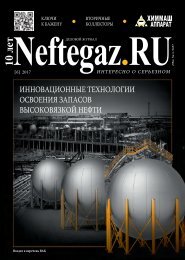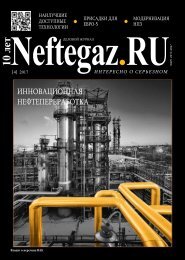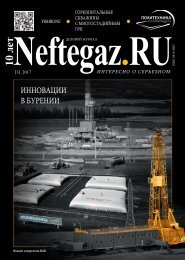Neftegaz.RU #3-17 ENG
Create successful ePaper yourself
Turn your PDF publications into a flip-book with our unique Google optimized e-Paper software.
OFS<br />
nine-points development pattern<br />
with the pattern arrangement 25<br />
and 16 hectares/well. Transversal<br />
fractures orientation for lowpermeability<br />
reservoirs is preferred:<br />
it provides higher productivity of<br />
the production wells, provides more<br />
extensive coverage of a reservoir,<br />
helps to bring into development<br />
multicompartment beds. But based<br />
on the results of the variants analysis<br />
the preference has been given to<br />
longitudinal fractures orientation<br />
due to the lowest risks for this<br />
system implementation and because<br />
of the complexity related to the<br />
waterflooding pattern arrangement<br />
for the system with transversal<br />
fractures orientation of hydraulic<br />
fracturing [1].<br />
Based on the hydrodynamic fluid<br />
simulation results, implementation<br />
of HW with multi-stage hydraulic<br />
fracturing on the experimental<br />
plot will allow not only ORF<br />
increasing by 5 percent but also<br />
reducing development period by<br />
more than two times as compared<br />
with the basic variant. The use<br />
of hydrodynamic fluid simulation<br />
models is one of the main means<br />
for designing; but notwithstanding<br />
its high accuracy, it is impossible<br />
to be confined with only these<br />
models applying for the purposes<br />
of development variants calculation<br />
due to availability of a large number<br />
of such variants and long time<br />
period required for the calculations<br />
performing. Under such conditions<br />
the reasonable approach is to<br />
use two-stage simulation, when<br />
preliminary calculations allowing<br />
reducing a number of variants and<br />
evaluating degree of impact of<br />
each parameter on oil production<br />
levels are performed at the first<br />
stage using analytical models, and<br />
adjustments with a help of numerical<br />
hydrodynamic calculations and<br />
selection of the best variant are<br />
performed at the second stage.<br />
The paper [2] proposes the following<br />
model for calculation of flow rate<br />
of horizontal well with multi-stage<br />
hydraulic fracturing and transversal<br />
fractures arrangement:<br />
(1)<br />
The given equation consists of two<br />
parts, the first term of the equation<br />
describes fluid inflow to the fracture<br />
space border excluding external<br />
parts of the outermost fractures<br />
draining areas.<br />
External parts of the outermost<br />
fractures draining areas are<br />
accounted by the following equation<br />
where<br />
(2)<br />
– fracture total area;<br />
– half the length of a fracture from<br />
hydraulic fracturing;<br />
– distance to external boundary.<br />
Pressure at the border of<br />
interfracturing space:<br />
where ,<br />
TABLE 2. Input data<br />
(3)<br />
Name of the indicator<br />
– length of a horizontal well;<br />
– number of fractures from<br />
hydraulic fracturing.<br />
Let us calculate flow rate of<br />
horizontal well with multi-stage<br />
hydraulic fracturing drilled under<br />
conditions of the producing bed<br />
АС11. The bed net oil pay thickness<br />
14 m. Rock pressure is 26 MPa,<br />
bottom-hole pressure is 5 MPa,<br />
average permeability of the bed<br />
is 3.5 · 10 -3 μm 2 . The input data for<br />
calculations are given in the table 2.<br />
One of the applied model<br />
disadvantages is the fact that fluid<br />
inflow to horizontal well having no<br />
fractures is not considered in the<br />
fluid flow rate calculations. Resulting<br />
uncertainty can be relevant when<br />
there is small number of fractures.<br />
But when number of fractures grows<br />
subsequently the error significantly<br />
decreases as far as the main part of<br />
the flow goes to the fractures. In this<br />
regard we do not consider HW with<br />
less than four fractures.<br />
The calculation results for fluid flow<br />
rate and pressure at the fracture<br />
space border are given in the<br />
Value<br />
Permeability of the bed k, 10 -3 μm 2 3.5<br />
Well length L, m 700<br />
Viscosity μ, mPa · s 1.4<br />
Rock pressure P rock , MPa 26<br />
Bottom-hole pressure P bh , MPa 5<br />
Half the length of a fracture x f , m 50<br />
Bed thickness h, m 14<br />
Distance to external boundary , m 300<br />
Volume factor b 1.2<br />
TABLE 3. The calculation results for fluid flow rate depending on hydraulic fractures number<br />
Hydraulic fractures<br />
number<br />
4 5 6 7 8 9 10 11 12 13 14 15<br />
P 0 , MPa 24.0 18.5 14.8 12.4 10.7 9.5 8.7 8.0 7.5 7.1 6.8 6.6<br />
Q, m 3 /day 148.0 186.9 212.7 230.1 241.9 250.3 256.4 260.9 264.4 267.1 269.2 271.0<br />
26 ~ <strong>Neftegaz</strong>.<strong>RU</strong> [3]














